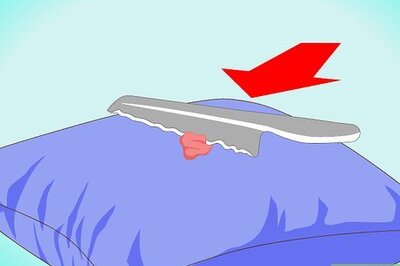
views
Telling the Differences Between Quadrilaterals
Know what a kite is. A kite is a type of quadrilateral (a 4-sided shape). It has two pairs of congruent sides. The 2 angles between the 2 pairs of congruent sides will also be congruent. The diagonals (lines that extend between opposite vertices) will be perpendicular to each other. At least one diagonal will bisect (divide into two) the other one evenly.
Know what a trapezoid/trapezium is. A trapezoid (also called trapezium) is another type of quadrilateral. A trapezoid will have at least one pair of parallel sides. These sides are named the "bases". In an isosceles trapezoid, a pair of opposite sides and angles will be congruent.
Know what a parallelogram is. A parallelogram has two pairs of parallel sides. Because the lines are parallel, the sides and angles opposite to each other will also be congruent. A parallelogram's diagonals bisect each other.
Know what a rectangle is. A rectangle is a type of parallelogram, meaning it fulfills all the requirements of one. A rectangle has two pairs of parallel sides, and a rectangle's diagonals will also bisect each other. Additionally, a rectangle has all 4 right angles. Each pair of a rectangle's opposite sides will be congruent.
Know what a square is. A square is even more specific. It is a type of parallelogram, and it is a type of rectangle too. A square has two pairs of parallel and congruent sides, and its diagonals bisect each other. Like a rectangle, a square has four right angles. However, a square's four sides are all congruent to each other. This means a square's two diagonals will also have the same length. The diagonals bisect in the center of the square, with each diagonal being cut into two congruent segments.
Proving Each Shape
Prove that a quadrilateral is a kite. This is a 4-sided shape with two pairs of congruent, adjacent sides. Their diagonals are also perpendicular to each other. One pair of opposite angles in the kite will be congruent. To prove that a quadrilateral is a trapezoid, check your diagram for any key information. Usually, the diagram will show you the kite divided into two triangles. Prove that these triangles are congruent using the information (on the angles or sides) you have. Using CPCTC (corresponding parts of congruent triangles are congruent), you can conclude that certain angles and sides of the kite are congruent. You could also try proving that the diagonals are perpendicular to each other using the Perpendicular Bisector Theorem.
Prove that a quadrilateral is a parallelogram. This is a general term for a quadrilateral with 2 pairs of parallel sides, congruent opposite angles, and diagonals that bisect each other. To prove that a quadrilateral is a parallelogram, check your diagram for any key information. You will likely need to use the triangle congruence theorems and some angle theorems (usually the Corresponding Angles Theorem or the Alternate Interior Angles Theorem and their inverses) For example, the shape may be divided into two triangles. You will have to prove that the 2 triangles are congruent to prove that the corresponding sides and angles are congruent. This will help you prove that the shape is a parallelogram. As a refresher, the Corresponding Angles Theorem states that if two parallel lines are cut by a transversal, then the pairs of corresponding angles are congruent. The Alternate Interior Angles Theorem states that when two parallel lines are cut by a transversal, the resulting alternate interior angles are congruent.
Prove that a quadrilateral is a trapezoid. This is a term for a quadrilateral with at least one pair of parallel sides (the bases) and angles next to each other that sum up to 180 degrees. For isosceles trapezoids, their base angles are congruent, and their intersecting diagonals also have a ratio of 1:2. To prove that a quadrilateral is a trapezoid, check your diagram for any key information. You will likely need to use the triangle congruence theorems and some angle theorems (usually the Alternate Interior Angles Theorem, the triangle congruence theorems, and their inverses).
Prove that a quadrilateral is a rectangle. This is a more specific term for a parallelogram with 4 right angles and congruent diagonals. To prove that a quadrilateral is a trapezoid, check your diagram for any key information. You will likely need the Alternate Interior Angles Theorem and the triangle congruence theorems. You will likely need to show that the shape is a parallelogram. You will need to determine if the shape has congruent opposite angles, parallel opposite sides, and bisecting diagonals. Then, figure out if the parallelogram has any right angles. If the rectangle is split in half diagonally (and the problem gives you information on its angles and/or sides), you can first prove that the triangles are congruent. Using CPCTC (corresponding parts of congruent triangles are congruent), you can conclude that the corresponding angles and sides of each triangle are congruent. This will allow you to say that the shape has opposite congruent sides or angles, which is why it is a parallelogram. Additionally, if the problem gives you information on its diagonals, you can prove those to be congruent using CPCTC.
Prove that a quadrilateral is a square. This is the most specific type of quadrilateral because all of its sides are congruent. Additionally, its diagonals are congruent and perpendicular to each other. To prove that a quadrilateral is a trapezoid, check your diagram for any key information. You will likely need the Alternate Interior Angles Theorem and the triangle congruence theorems. You might also use the Perpendicular Bisector theorem (to prove that the quadrilateral's diagonals are congruent). First, prove that the shape is a parallelogram using the steps above. Next, you can specify and prove that the parallelogram is a rectangle by finding out if it has right angles. Lastly, prove that it is a square by proving every side of the rectangle to be congruent. You could divide the rectangle up into two triangles and prove the two triangles to be congruent using the information you have. Additionally, you could also use the information on the diagonals by proving them to be perpendicular to each other and congruent (without having to prove each side of the square as congruent).




















Comments
0 comment